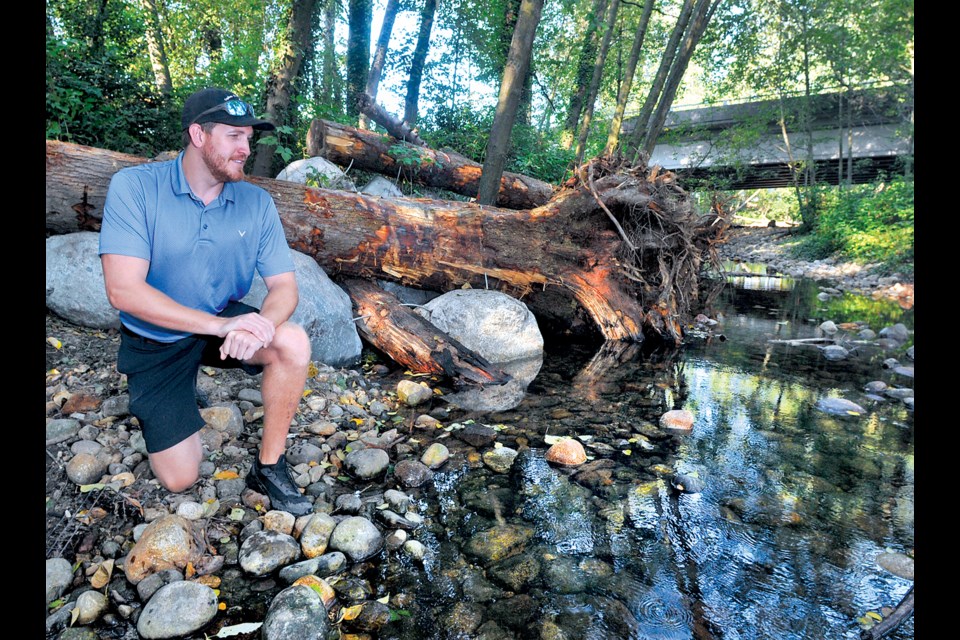Salmon that spawn in three North Shore creeks this fall are returning to much better habitat than they left, thanks to the work of local stewardship groups.
The West Vancouver Streamkeepers, the Seymour Salmonid Society and the North Shore Streamkeepers spent the summer moving boulders and logs to recreate the conditions that once drew in thousands of salmonids per year, but thanks to human activity, have left the creeks bordering on barren in modern times.
North Vancouver’s Mosquito Creek coming back to life
The North Shore Streamkeepers, with the help of a walking spider excavator, manoeuvred dozens and of logs and hundreds of boulders to 130 metres of Mosquito Creek beyond the Bewicke Avenue bridge.
Because the creekbanks have been armoured with rap-rap over the years, water flows through at a much faster rate, taking all of the natural gravel, woody debris and biological material that fish need with it and making the creekbed “like concrete,” said Keegan Casidy, president of the North Shore Streamkeepers.
“If they can’t dig in there, there’s no nest. If there’s no nest, there’s no eggs and no fish,” he said. “There was no shelter, no cover, no ability for that area of the stream to recruit sediments and finer materials. It couldn’t even really recruit spawning gravel. No organic matter means very little life.”
With the logs and boulders in place, the creek will look and behave much more like it would have had humans never interfered with the riparian area. Salmon in the inlet will sense the woody debris and come in.
The project builds on the “shocking” success the group already had on the lower section of the creek, which they rehabilitated in 2021. Most years, volunteers on Mosquito Creek would go without spotting a single salmon. Since the project was completed, they’ve being getting at least 20 per year.
Casidy said he has a goal of 100 chum salmon swimming around in Mosquito Creek when they return from their four-year cycle in 2028, and 100 pinks in 2027. But if the groups continue their restoration work on the creek all the way up to the highway, the potential is hard to imagine by today’s standards.
“I’m hoping that one day we’re going to eclipse the 1,000-fish-per-year mark,” he said. “There was certainly years where there were thousands upon thousands returning.”
West Vancouver’s Cypress Creek restored
West Vancouver’s Streamkeepers have cleared a way for salmonids to make their way past a barrier on Cypress Creek, said Keith Pelletier, co-chair for the group.
The concrete weir was installed by the federal government, ironically, to divert fresh water to a laboratory, known today as the Pacific Science Enterprise Centre on Marine Drive. Today, the Department of Fisheries and Oceans has been highly supportive of helping mitigate its impacts on fish, Pelletier noted.
Using the same spider excavator, contractors built a series of pools, each one slightly higher than the one below it, “so the fish can just naturally jump over the weir.”
“There’s fantastic spawning and rearing habitat just above that,” Pelletier said, adding that volunteers have already spotted the first returning coho of the fall run to make it above the weir.
Historically every salmonid species, with the exception of sockeye, have relied on Cypress Creek.
“The old-timers tell us it was one of the biggest pink runs on the North Shore,” Pelletier said.
In 2025, if the Streamkeepers can net all the necessary approvals and grant funding, they have plans to make big improvements to the creek below Marine Drive, which suffers from the same degradation that most urban creeks have.
“When that river floods in the fall and winter, it just scours it out so there’s no spawning habitat left. It’s just run on all the gravel right out to the estuary,” he said. “What we’d like to do is restore it back to the productive stream that it once was and that’s our ultimate goal.”
Seymour River rockslide project finished
The Seymour Salmonid Society, meanwhile, has put the finishing touches on a years-long project to reopen the Seymour River after a 2014 rockslide blocked any hope of fish returning to spawn.
Since the slide, specialists have been using low-velocity explosives to break apart the larger boulders into smaller ones, which the winter rains wash into the canyon below.
The slide first became passable again in 2019, but society president Shaun Hollingsworth said in years with low rainfall, the fish still find themselves stuck. That’s exactly what happened in drought conditions in 2023.
“Pink salmon only spawn every two years, and the pink salmon didn’t make it through last year. They stayed in the bottom of the river, and whether they spawned or not, I’m not sure,” he said. “What we felt was water levels were too low, and the incline that they had to climb was too high.”
Crews recently finished breaking apart rocks at the “lip” of the slide, which should lower it by 1.5 metres. With that done, Hollingsworth said he has every confidence in the river’s future as fish habitat.
“It’s come back to as good as, if not better, than prior to the slide,” he said. “We’re getting good runs of fish. And you know, if things go well, in four years, we should be able to open it to fishing.”
All three projects were planned in detail by Northwest Hydraulics Consultants, a North Vancouver-based firm.




